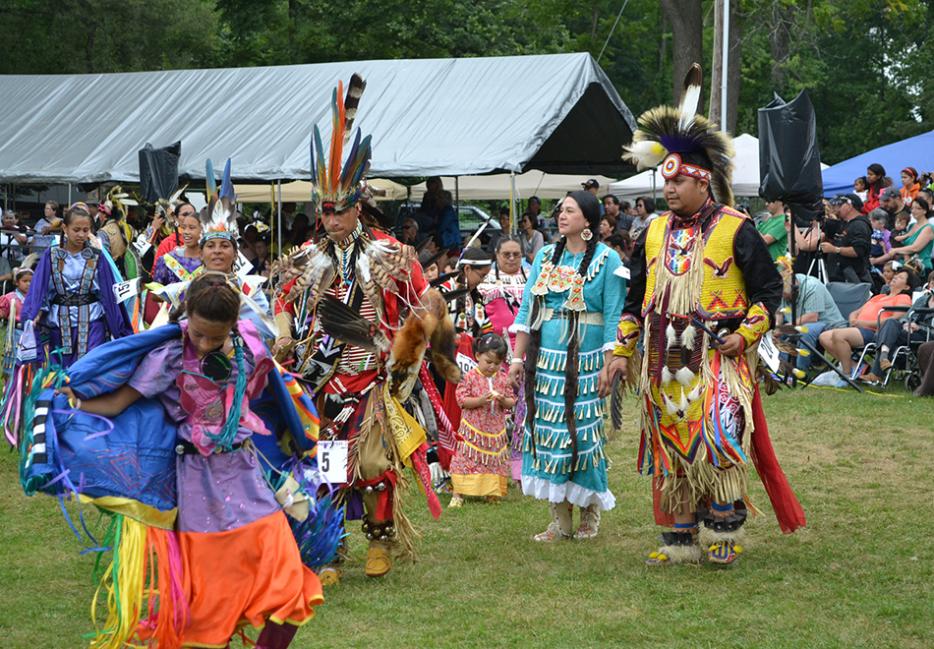In late July 2012, there was a booth at the Grand River Pow-Wow selling gag t-shirts that said “FBI: Fry Bread Inspector.” The Pow-Wow is a sort of county fair for the Six Nations of the Grand River Territory in southwestern Ontario: the Mohawk, the Cayuga, the Onondaga, the Oneida, the Seneca, and the Tuscarora. Teenaged boys in fringes and feathers performed traditional grass dances, then wandered through crowds of kids in flip-flops and white tourists in Tilley hats. A few booths over from the fake FBI shirts, there was a booth handing out bonafide spy material: job application forms for CSIS.
“Canadian Security Intelligence Service,” a man in a red shirt with a black mustache enunciates prissily for a Native woman with long black hair who is clearly there to take the piss. Her name is Francine “Flowers” Doxtator, a First Nations activist, and this encounter, videotaped by Zach Ruiter, is archived on the independent media site Toronto Media Co-op. The man with the mustache asks Ruiters to stop taping.
“Don’t you run around videotaping and spying on people?” asks a tall white guy with a beard.
“I can’t make any comment on that,” the mustache man says.
“But that is what you guys do?” the tall man counters, and the mustache man holds out his hands and shrugs.
“They like Aboriginal people a real lot,” Doxtator says, laughing. “They have all kinds of pictures of us.”
“No, I don’t have a secret identity,” a Native woman behind the CSIS table says huffily to someone off-camera. “Do you think if I had a secret identity, I would be here?”
“They have a file on me this thick,” Doxtator says to the camera, holding her thumb and forefinger inches apart. “To try and recruit Aboriginal children here? That’s wrong.”
This year, CSIS was back at the festival. And whether or not recruiting more Aboriginals into CSIS is, as Doxtator says, morally wrong, it’s a very, very tough sell. Over the past two years, major media outlets have been reporting on CSIS’ extensive spying on First Nations groups. Earlier this month, the National Post reported that in January, a branch of CSIS called the Integrated Terrorism Assessment Centre put together a threat assessment on Idle No More, the protest movement accompanying Attawapiskat Chief Theresa Spence’s hunger strike early this year. In 2011, CBC Radio’s The Current aired a feature interview with Cindy Blackstock, executive director of the First Nations Child and Family Caring Society of Canada. By filing a Freedom of Information Act request on herself, Blackstock found that CSIS had a 400-page file on her, and that government had secretly hacked into her personal Facebook page and accessed other private information on her. This May, Privacy Commissioner Jennifer Stoddart delivered a report confirming wrongful surveillance of Blackstock.
“Never figured I’d see the day where I was rigged to a wire...by a white man, no less,” says Silas Garrow, a Mohawk character in Craig Davidson’s new novel, Cataract City. Garrow and the white cop, Owen Stuckey, are sitting in a cruiser near Niagara Falls, and Garrow is being fitted out for a meeting where he’ll entrap Lemuel Drinkwater, a smuggler, dog-fight mogul, and all-around bad guy from the Tuscarora clan. It’s telling that the reason Stuckey is able to convince Garrow to take part in the sting is because Stuckey’s best friend, another white character named Duncan Diggs, got to know Garrow in one of the few places where Davidson describes whites and Natives fraternizing—jail. Davidson’s novel relies in part on the classic trope of criminal and cop as two sides of the same coin; just folks who live in the same community and have the same friends.
Which is why CSIS and the RCMP hope they can keep tabs on First Nations groups while simultaneously presenting themselves as the friendly Neighbourhood Watch that could use a few more Native neighbours out on the block.
Canada woke up to the idea that more diversity on its police forces would make for better policing in the late 1980s, and has since gone through several waves of new recruitment tactics. The RCMP has been establishing dedicated positions for Native officers as recruitment specialists since the early 2000s, and in 2011 (according to the recruitment plan accessed by Media Co-op journalists through FOIA) CSIS hired their first officer dedicated to recruiting Aboriginals: Maureen Greyeyes-Brant, a former RCMP officer. According to the CSIS 2012–2013 national recruitment plan, only 1.6 percent of its employees self-identify as First Nations or Métis. In the RCMP, it’s currently about 8 percent.
Of course, First Nations people are not like other minorities in Canada. Because First Nations are just that—nations—trying to get Aboriginals to join a Canadian spy agency isn’t just asking them to engage in espionage. It’s asking them to engage in espionage for a country of which many don’t consider themselves citizens. It’s a bit like if the KGB asked you to join them—it sounds like becoming a traitor.
“That don’t happen here,” Francine Doxtator says in the video. She’s no longer laughing, but glaring straight into the camera. “Our blood don’t go against our own blood.” As any gag t-shirt stand can inform you, FBI doesn’t just stand for Fry Bread Inspector—it also stands for Full-Blooded Indian.
Every week, Linda Besner reads a new book and writes on a tangentially related topic.






